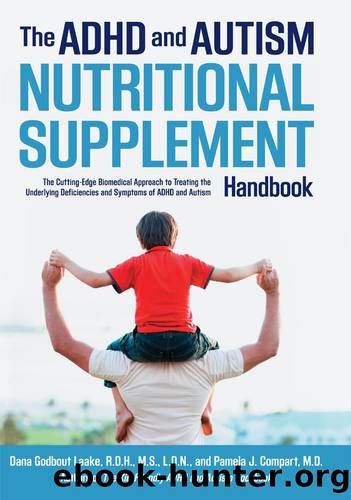The ADHD and Autism Nutritional Supplement Handbook by Dana Laake

Author:Dana Laake
Language: eng
Format: epub
Publisher: Fair Winds Press
Published: 2013-10-15T00:00:00+00:00
DOSE
5 to 10 mg
FREQUENCY
1 or 2 times per day
TOTAL DAILY DOSE FROM ALL SOURCES
10 to 20 mg
AGE
6 to 10
DOSE
10 mg
FREQUENCY
2 times per day
TOTAL DAILY DOSE FROM ALL SOURCES
20 mg
AGE
11 +
DOSE
10 to 15 mg
FREQUENCY
2 times per day
TOTAL DAILY DOSE FROM ALL SOURCES
20 to 30 mg
For optimal oral absorption, an empty stomach is best, but it may not be feasible if nausea occurs. Large doses can cause gastric discomfort, nausea, and inhibit the digestive enzyme DPP-IV (digests opioids from gluten and casein). In addition:
⢠Avoid or limit giving zinc at the same time as interfering nutrients such as calcium, iron, folate, and phosphorylated nutrients (R5P, P5P, phosphatidylcholine); this may not always be feasible.
⢠Zinc excess can lower copper levels. Copper levels need to be maintained.
⢠Use the Zinc Tally Taste Test in section 4.9 for evaluating progress with zinc supplementation.
⢠Higher doses may be required due to poor absorption, antacid use, the presence of toxic metals, or lab findings of deficiency. This should be accomplished with a health care practitioner.
Section C: Food Intolerances and Elimination of Opioid Food Culprits
Food intolerances impact significantly on sensory sensitivities. A full discussion of food intolerances is beyond the scope of this book. More information and resources are available in section 4.17 Digestive Enzymes and section 6.1 Gluten-Free Casein-Free Soy-Free (GFCFSF) Diet.
In short, food proteins, particularly those from milk (casein) and wheat (gluten), may be incompletely digested to peptides and may enter the bloodstream from the intestine via an abnormally permeable intestinal lining (referred to as âleaky gutâ). These partially digested protein peptides can potentially cross the bloodâbrain barrier, negatively affecting brain function, and contributing to mood, attention, and behavior by several mechanisms:
⢠Blocking neurotransmitter messages
⢠Creating opiate-like doping effects from gluten (gliadorphin), milk casein (casomorphin), and soy
⢠Triggering brain inflammation
The most obvious symptom is craving for the food opiate sources (gluten, milk products, and soy). The opioid effect can also contribute to inattention, language and communication delays, poor eye contact, irritability, and increased self-stimulating behavior. Effects may occur within an hour of consumption or be delayed up to seventy-two hours.
What to Do and How to Do It
Provided here is a brief summary of two main treatment strategies for food intolerances and the opioid effect.
1. GFCFSF DietâElimination Trial: the âgold standardâ for treatment
⢠The most common problem food proteins are gluten, milk casein, and soy.
⢠Your childâs body is the best test. Eliminate the food(s) to see whether behavior improves and reintroduce or challenge the body to see whether behavior worsens.
2. Digestive enzymes, including dipeptidyl peptidase-IV (DPP-IV)
⢠More efficiently digest gluten, casein, soy and other food proteins, carbohydrates, and fats.
⢠Reduce the opioid load due to insufficient DPP-IV enzyme function; this can also âmimicâ the diet.
Digestive Enzyme Supplements
See section 4.17 Digestive Enzymes for detailed information on specific enzyme products and dosing.
Download
This site does not store any files on its server. We only index and link to content provided by other sites. Please contact the content providers to delete copyright contents if any and email us, we'll remove relevant links or contents immediately.
| Allergies | Asthma |
| Autism & Asperger's Syndrome | Cystic Fibrosis |
| Down Syndrome | Eating Disorders |
| Epilepsy | Learning Disorders |
| Lice | Special Needs Children |
I Capture the Castle by Dodie Smith(2010)
The Heavy by Dara-Lynn Weiss(1787)
Aspergirls by Rudy Simone(1680)
Be Different by John Elder Robison(1622)
Autism's False Prophets by Paul A. Offit(1512)
My Child's Different by Elaine Halligan(1485)
Smart but Scattered—and Stalled by Richard Guare(1474)
101 Tips for the Parents of Boys with Autism by Ken Siri(1458)
What's Making Our Children Sick? by Michelle Perro(1401)
Asperger Syndrome (Autism Spectrum Disorder) and Long-Term Relationships by Ashley Stanford(1393)
ADHD by Mark Selikowitz(1373)
Girlish by Lara Lillibridge(1356)
On Immunity: An Inoculation by Biss Eula(1344)
Nerdy, Shy, and Socially Inappropriate by Cynthia Kim(1325)
An Adult with an Autism Diagnosis by Gillan Drew(1322)
Animal-assisted Interventions for Individuals with Autism by Temple Grandin(1300)
Sarah's Child (Hqn Romance) by Linda Howard(1292)
The Cities by K.A Knight(1284)
Seeing Ezra by Kerry Cohen(1281)
